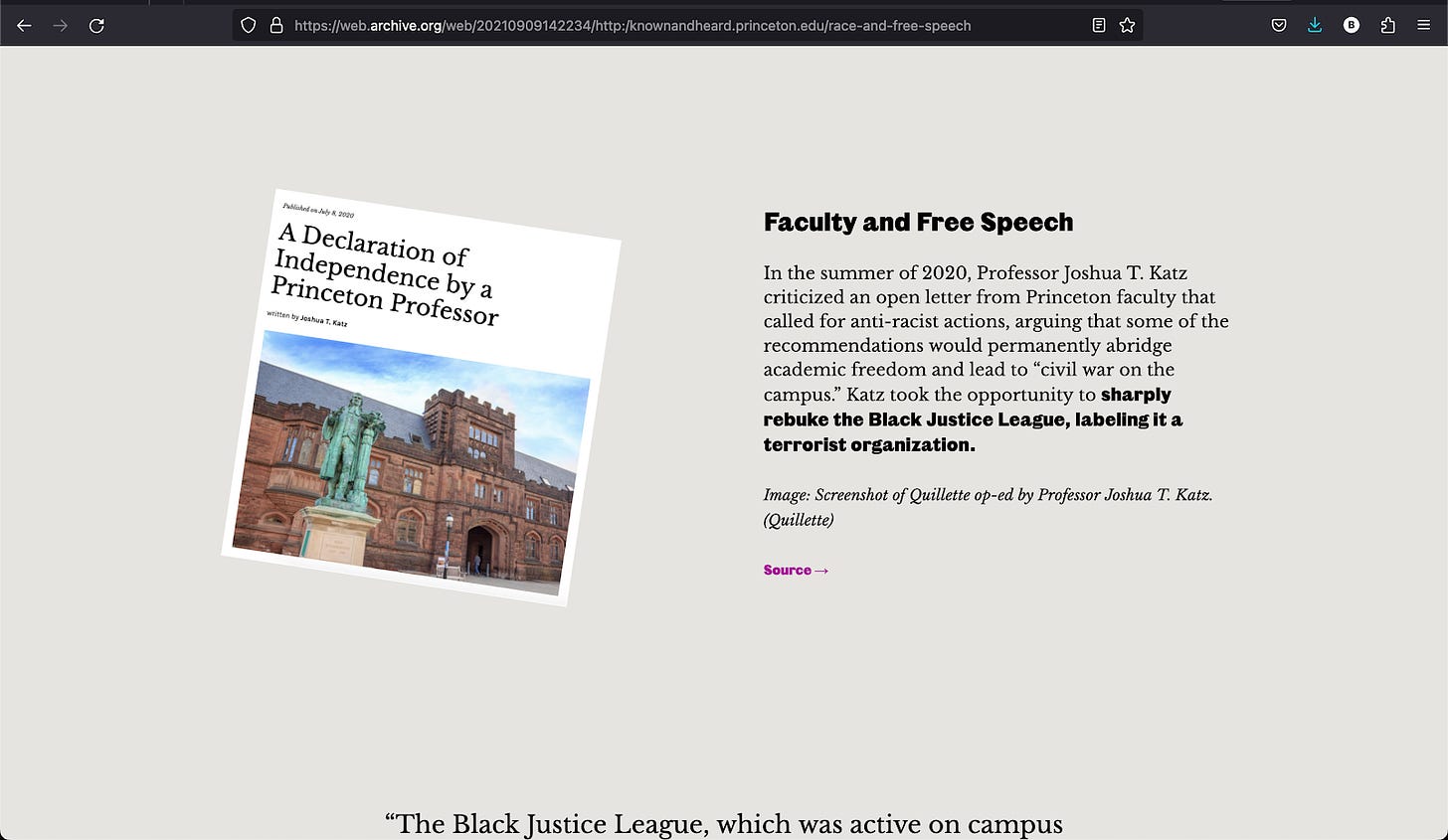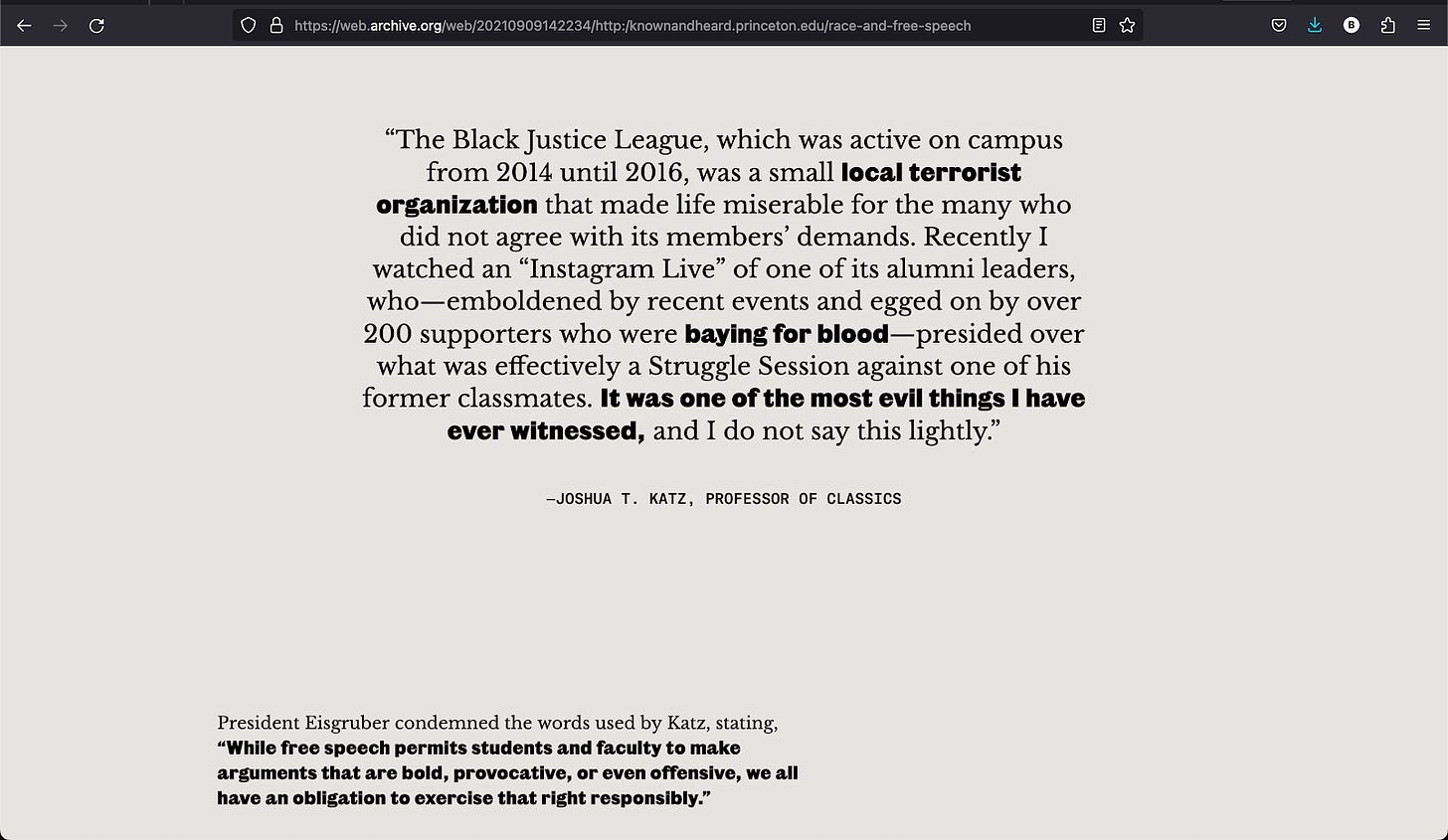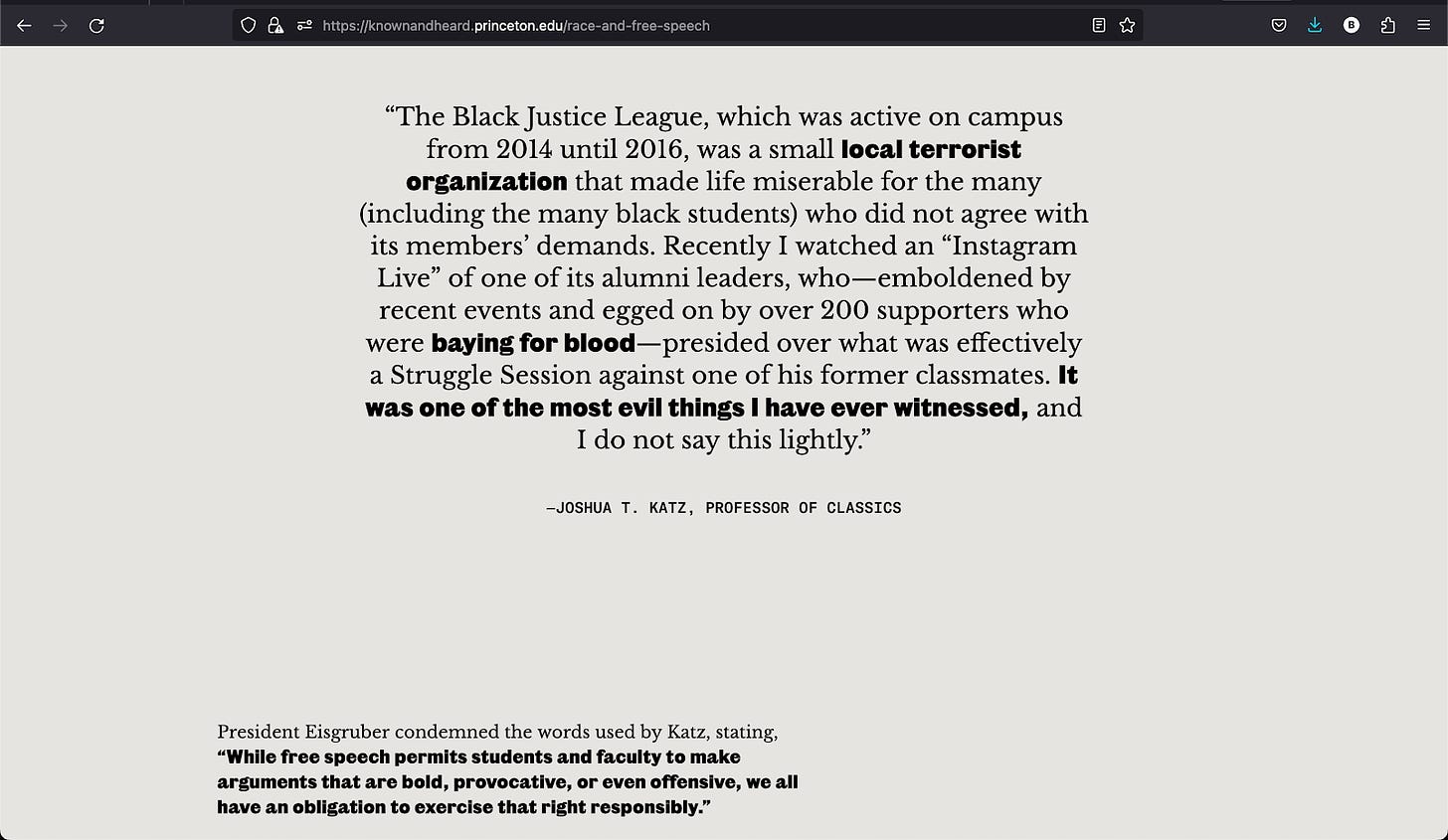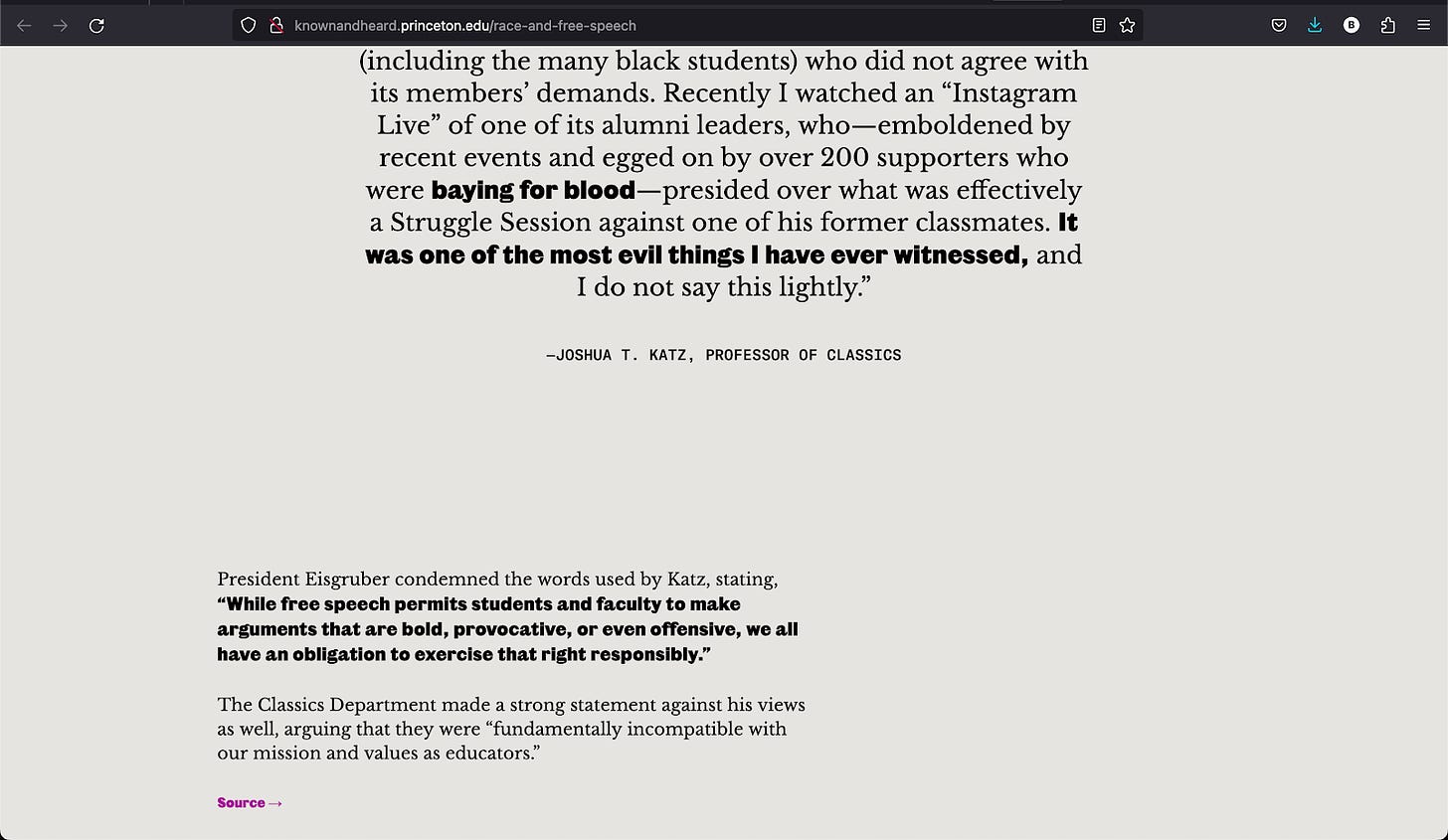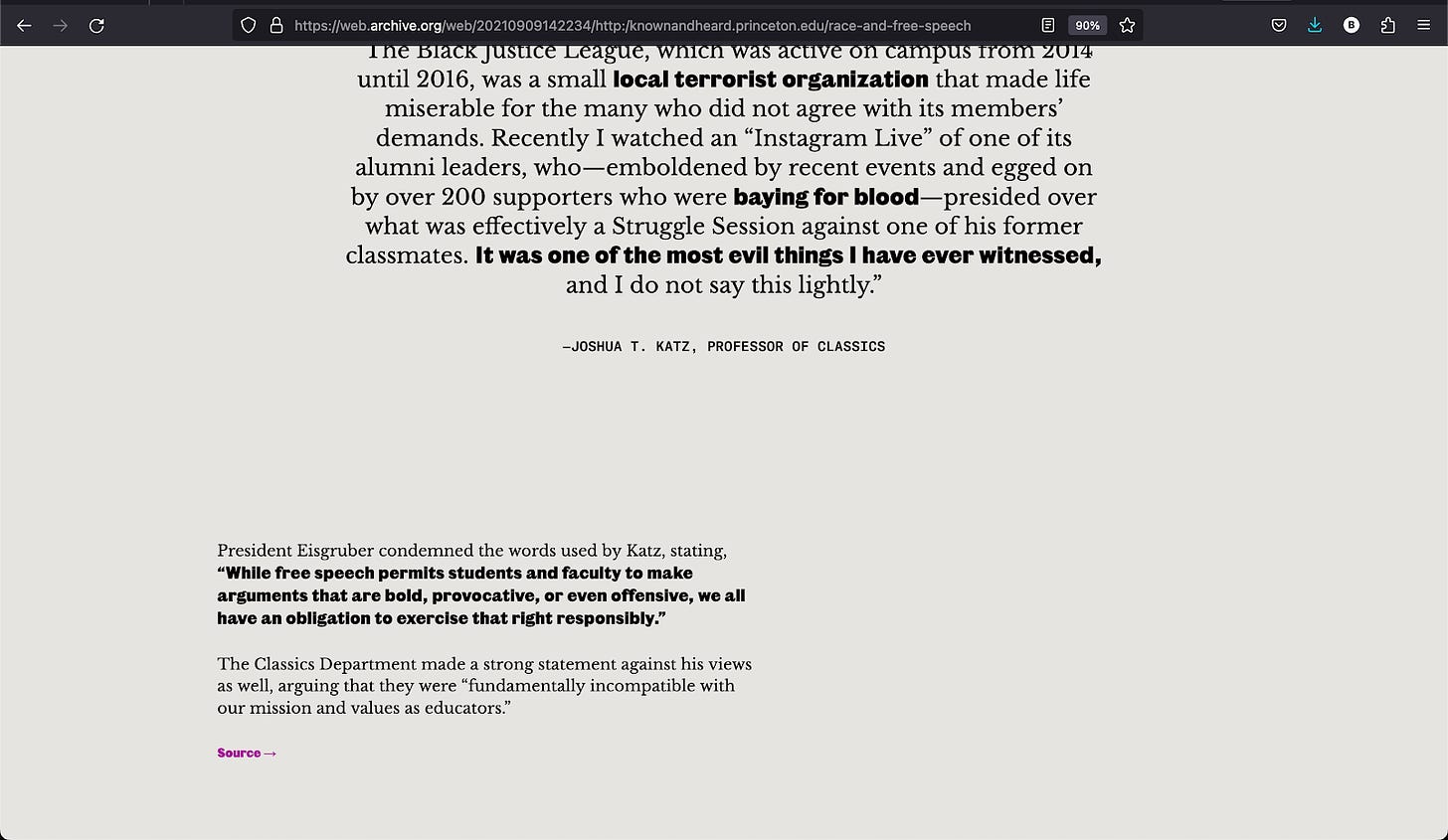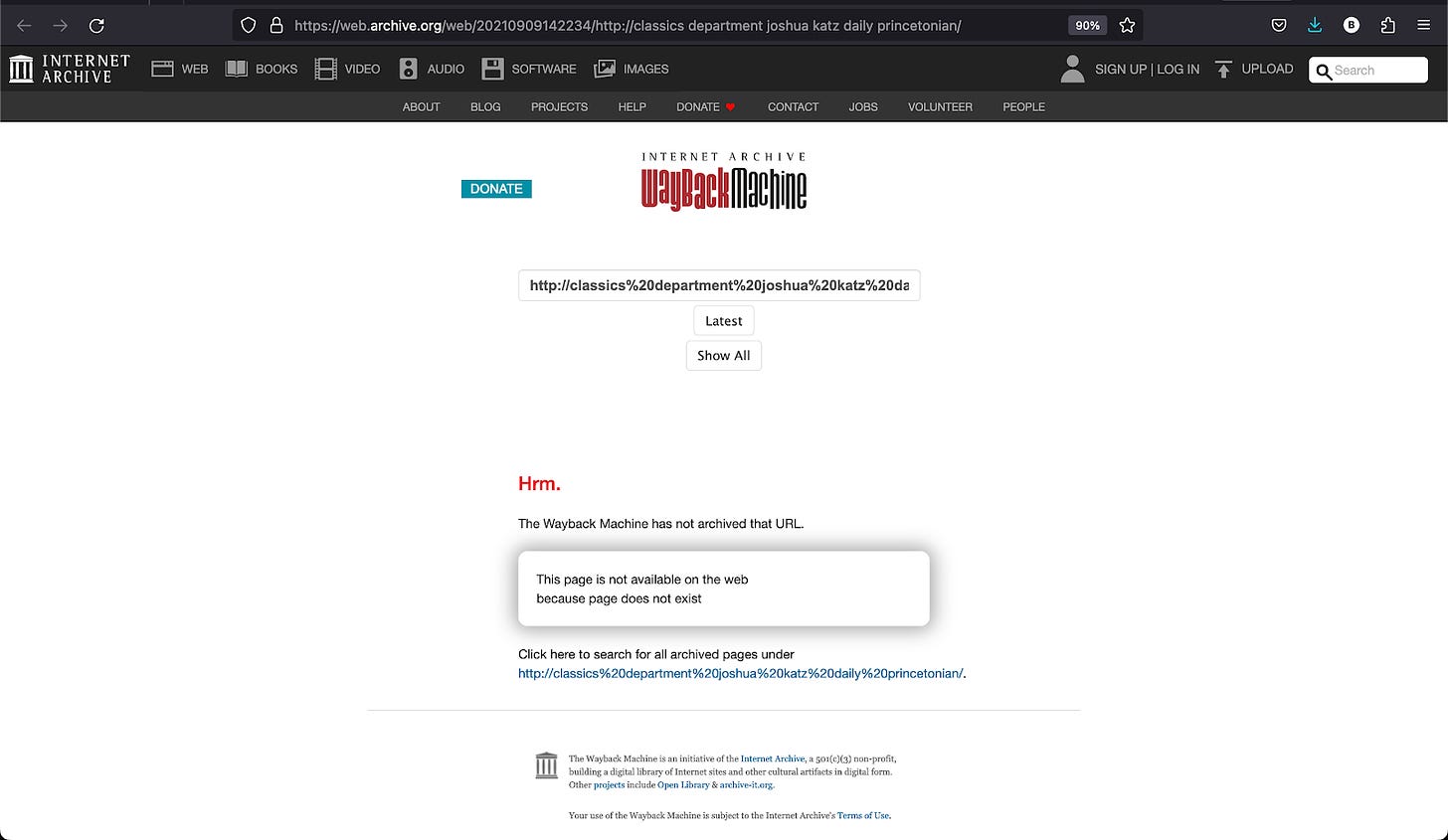Defamation of Joshua Katz by Princeton's "To Be Known and Heard" Publication
The Complaint for Defamation to Princeton's CPUC
Open Letter
Via Email
May 7, 2023
Ms. Christine Gage
Secretary of the Council
Council of the Princeton University Community
Re: Defamation of Joshua Katz by the
"To Be Known and Heard" Publication
Secretary Gage:
Pursuant to Princeton University Rights, Rules, Responsibilities 1.9.3.1, I file this complaint before the Council of the Princeton University Community.
A 2020 Faculty Letter, the response by Princeton’s Joshua Katz in Quillette, and a certain statement in the latter failed to begin a productive public debate, and instead combined to trigger an avalanche of destruction and tragedy – for Princeton. Perhaps I shall further explore and set forth my thoughts on this tragedy in another forum. I welcome others to do likewise, as I regard this entire saga to be a proper subject for deep reflections for all who care about the Princeton of today and the Princetons of tomorrow.
The complaint I set forth below arises from what I understand to have been part of the University’s orientation of the first-year Class of 2025. Such programs entail editorial judgments on how best to use the occasion. Although a participant may explore the limits of free speech elsewhere (for example, the posting on a private YouTube channel of a recitation of the Manhattan telephone directory), for a University-sponsored program the University has certain interests in – and indeed certain obligations to - the exertion of some degree of editorial control over content.
One of the obligations of the University attendant to such a program is not to permit – nor allow to continue – defamation.
Beginning in late 2020 or early 2021 and continuing for a significant period of time thereafter, “Project Leads” Carl A. Fields Center for Equality and Cultural Understanding and Office of Wintersession and Campus Engagement – along with attendant Co-sponsors, Advisory Group, Research, and Design – created and set forth a publicly-available online publication “To Be Known and Heard: Systematic Racism and Princeton University” (the “Presentation”) using Princeton University IT Systems. I enclose for your reference Exhibit A – a screenshot from the Presentation showing and referencing a certain Quillette article by Joshua Katz. I further enclose Exhibit B – a screenshot of a purported verbatim quote of Joshua Katz set forth in the Presentation. Exhibit B is the trigger for this complaint. As explained further below, I believe the Presentation defames Joshua Katz.
I note that to the best of my knowledge the University has not yet addressed the issue of defamation in regard to the Presentation. Indeed, in her December 7, 2021 response to an online discrimination/harassment complaint filed by Professor Sergiu Klainerman regarding this matter, Vice Provost for Institutional Equity and Diversity Michele Minter forthrightly stated, “[O]ur assessment . . . does not consider . . . defamation.”
Specifically, I believe the Presentation to violate the Section 3.c of “Acceptable Use Policy For Princeton University Information Technology & Digital Resources” as relates to University “IT Systems” (as defined therein). Section 3.c states, in part, “From any location, University resources may not be used to transmit . . . defamatory content.” Let me emphasize that the issue of defamation by the Presentation does not rest on the intent behind it, but rather upon the truth of the public representation it makes.
I further note that to the extent it defames, the Presentation does not fall within the University’s free speech protections, as is made explicitly clear in the exception for defamation set forth in the 1.1.3 “Statement on Freedom of Expression” of the University’s Rights, Rules, Responsibilities (the “RRR”).
RRR 1.1.2, “Academic Integrity” explains why such acts as I bring to the CPUC in this complaint – in their demonstrated lack of “quality and integrity” – strike at the heart of Princeton’s mission. This section states in part and properly emphasizes, “The ability of the University to achieve its purposes depends upon the quality and integrity of the academic work that its faculty, staff, and students perform. Academic freedom can flourish only in a community of scholars which recognizes that intellectual integrity, with its accompanying rights and responsibilities, lies at the heart of its mission. Observing basic honesty in one’s work, words, ideas, and actions is a principle to which all members of the community are required to subscribe.”
I add, further, that because of the overall context of the Presentation, including various related controversies preceding its publication, there arises an issue of intent on the part of those who composed and published the Presentation – that is, whether any of them had an intent to depict Joshua Katz (then a Princeton University Professor) in a manner to inflict public calumny upon him. This question has substantial foundation.
Princeton Politics Professor Keith Whittington has stated, “[T]here’s the concern that university administrators are engaging in a campaign of intimidation and harassment against him.” Professor Whittington is a co-founder of the Academic Freedom Alliance. The AFA said this in its March 27, 2022 letter to President Eisgruber: “[I]t is hard to see the actions of the Carl Fields Center as anything other than ongoing retaliation for Professor Katz’s speech. . . . It is not an example that should be followed or repeated if universities are to remain vibrant centers of intellectual freedom.” Similar concerns regarding the Presentation and its troubling history have been raised by Professor Sergiu Klainerman and other faculty members, and also by Princetonians for Free Speech in a March 15, 2022 open letter to Princeton’s Board of Trustees. That letter, however, did not explicitly raise defamation among the many issues it did in relation to the Presentation.
It is now time for the Trustees – and the entire Princeton community – to confront the problem of defamation and the damage it wreaks on Princeton.
A specific aspect of this issue of intent – and beyond whether the Presentation was defamatory – is whether the Presentation was “malicious” under Section 3.c of the previously referenced “Acceptable Use Policy.” Here is the operative sentence from Section 3.c now presented in full, “From any location, University resources may not be used to transmit malicious, harassing, or defamatory content.”
I ask that the University forthwith commence a full investigation into this matter, with applicable subsequent actions and measures, including restorative justice not only for Joshua Katz, but extending as well to the members of the then-first-year members of the Class of 2025 (whose viewing of the Presentation was specifically promoted by the University) and to the members of the Princeton University community and the public at large who viewed this Presentation. This Presentation misled all its viewers by the wrongful statement it attributed to then-professor Katz. Amends must be made, not only for Joshua Katz, but also for the diminishment the Presentation caused to the reputation of Princeton University as a trustworthy institution.
Here is the statement central to my assertion that the Presentation defamed Joshua Katz: "The Black Justice League, which was active on campus from 2014 until 2016, was a small local terrorist organization that made life miserable for the many who did not agree with its members' demands. . . ." (Please refer to Exhibit B.) This quote, by its manner of presentation, ostensibly set forth the very words of then-professor Katz in his Quillette opinion, which opinion the Presentation in its introduction to this quote explicitly referenced by text and image. (Please refer to Exhibit A.)
The Presentation placed in bold type the words “local terrorist organization.” Of that, I say “fair” – as Katz’s use of that phrase had been the subject of great controversy among Princetonians. The ostensibly quoted statement – as set forth by the Presentation – when taken as a whole is a decidedly different matter. It omits Katz’s original text – “(including the many black students)” – and even does so without the use of ellipses or other indication of alteration. Of this, I shout, “FOUL!”
By elimination of Katz’s parenthetical – “(including the many black students)” – the Presentation casts Katz in a role the opposite of what his words – when taken as a whole – indicate. Katz had condemned a group “that made life miserable for the many (including the many black students) who did not agree with its members’ demands.” (Bold added for ease of identification.) Katz’s original words had spoken out specifically on behalf of “black students” as well as others on campus – both of whose numbers were “many” – and who, because they did not agree with the group he cited, the group in his judgment had “made life miserable” for them.
Instead, by its secret elimination of “(including the many black students)” the Presentation turns Joshua Katz from a defender of “black students” into an attacker of a black student group. This highly troubling deception has also come under attack from the Academic Freedom Alliance. Simply put, this act bears hallmarks of simple dishonesty and should incur the full force of RRR 1.1.2, “Academic Integrity”.
Further worsening its defamation, the Presentation fails even to attempt to offer an even-handed inquiry into what Katz reasonably intended with his use of the word “terrorist.” (Is it really to assert the actual commission or threat of violence? Has it instead another meaning, going to one who induces “terror” – commonly (but not exclusively) understood as “a state of intense or overwhelming fear”? Or does it mean something else?) Likewise, that the phrase “terrorist group” could be seen as the use of metaphor or hyperbole and therefore not warrant particular notice, much less condemnation, the Presentation utterly avoids.
Similarly, the Presentation chose silence on the salient issue of what behavior, if any, might support Katz’s statement that this student group had “made life miserable” for those “who did not agree with its members’ demands.” On this, I note for the record – as but one example – the November 18, 2015 Daily Princetonian article “Updated: Students “walkout and speakout,” occupy Nassau Hall until demands of Black Justice League are met.”
That article quotes the person it identifies as the BLJ organizer of the occupiers, “We’re done talking. We’re going to be here until he signs this paper. We’re going to be here until things are met.” This quoted statement creates a prima facie case of threatened coercion.
Similarly, President Eisgruber may or may not have felt “miserable” to face the prospect of the loss of use of his office – not to mention control of his working schedule – until he acceded to the demands with which the BLJ confronted him in what up until then had been working space designated by the University for his use and not to my knowledge a venue for protest.
And aside from President Eisgruber’s subjective personal feelings during this event, there remains the question of whether these actions by the BLJ participants constituted violations — including flagrant breaches — of any applicable provisions of the University’s Rights, Rules, Responsibilities. The Presentation failed to acknowledge this issue. I direct the attention of readers interested in further exploration of this issue to RRR 1.4.7 Property regarding “[u]nauthorized occupation of . . . University spaces” and RRR 1.2.3 Peaceful Dissent, Protests, and Demonstrations for additional applicable restrictions, limitations, and prohibitions.
Similarly, the Presentation quotes Joshua Katz’s statement from his Quillette opinion about the BLJ: “Recently I watched an ‘Instagram Live’ of one of its alumni leaders, who . . . presided over what was effectively a Struggle Session against one of his former classmates.” The Presentation presumably could have linked to this referenced “Instagram Live” video (or otherwise have obtained from the BLJ or whoever controlled the video a copy of it for such posting) and let readers judge for themselves whether or not Katz gave this “Instagram Live” episode a fair depiction. And if the such parties who controlled the video chose not to make it so available, certain inferences as to the nature of its content can reasonably be drawn.
All of this is in the context of the Presentation’s styling itself from its beginning and throughout as a critique of “systematic racism” at Princeton and directing the reader’s attention to “racist statements and actions“ at its introduction to the “Race and Free Speech” chapter, where the Presentation positioned the defamatory misquote of Katz. The effect of the Presentation is to give the reader a wrongful rendering of his character.
The Presentation, it must be noted, provides vivid – but presumably unintended – irony in its accompanying quote of Princeton’s President Eisgruber on the “obligation to exercise that right [of free speech] responsibly.” (Please refer to Exhibit A.) Here the Presentation – in an act of either (1) utter lack of self-awareness or, yet worse, (2) knowing arrogance – invokes this Eisgruber quote to further condemn Katz for his use of the phrase “terrorist organization” while on its very same screen the Presentation commits either gross negligence or an underhanded and malicious attack most foul – either of which (negligence or attack) are manifest derelictions of responsible speech.
Eventually – and after wide-spread and pronounced criticism – the Katz quote was changed to reflect correctly what Katz actually wrote in his Quillette piece. (Please refer to Exhibit C, enclosed.) This happened sometime before the March 27, 2022 AFA letter to President Eisgruber. But great damage had already been done to two reputations – Katz’s and Princeton’s.
Just who made this change, at whose request and why they had not done so previously, I do not know. And these questions are but a few of the many questions bearing upon intent that the University must pursue with fully and with vigor.
Even the correction carries with it an invisible – yet distinct – odor of disgrace. There is no indication provided by the Presentation that the quote had ever been in error, much less even a perfunctory apology or expression of regret. The Academic Freedom Alliance also took note of this troubling smell.
Before proceeding to conclusion, I draw attention to another quote the Presentation makes concerning Joshua Katz. Just below its quote of President Eisgruber in Exhibit B, the Presentation next quotes the Classics Department: “The Classics Department made a strong statement against his [Katz’s] views as well, arguing that they were ‘fundamentally incompatible with our mission and values as educators.’” (Please refer to Exhibit D for a current screenshot of the quote and its supporting link.)
This entire condemnatory quote raises questions that I leave for the forthcoming investigation (and other interested parties) to resolve. Foremost among them is whether the Classics Department still stands by the statement the Presentation even to this day still attributes to it. The supporting link on the currently posted webpage does not presently respond. Moreover, when I attempt the link to the legacy version on the Internet Archive, the result goes to a page reporting, “This page is not available on the web because page does not exist”. (Please refer to Exhibits E and F.)
If the facts yet to be established show that the Classics Department no longer stands by the quote the Presentation attributes to it, then we are confronted with another example of the Presentation’s defamation, dereliction, and possible malice.
By copy of this Complaint to Classics Department Chair Professor Barbara Graziosi, I request that she promptly inform the CPUC as follows, with answers to the best of his knowledge: (1) Did the Classics Department ever make the quoted statement attributed to it by the Presentation? (2) If so, does the Department still stand by this statement? (3) If not, when did it cease to stand by this statement? (4) Why, if that is the case, does the Department no longer stand by this statement? (5) If the Department no longer stands (or ever stood) by this statement attributed to the Classics Department, did she ever become aware that the Presentation continues this statement attributed to the Department? (6) Did she or any other professor, staff or student in the Department ever inform any of the parties involved in the creation and/or maintenance of the Presentation that this attribution was wrong? (7) If so, who said what to whom, and what responses – if any – were given at that time or later?
In order to facilitate the integrity of this investigation, I further ask that the University implement immediate and full measures to identify, preserve and maintain all potentially relevant records – electronic and otherwise – that may pertain to this matter, including texts, voicemails, and telephone call logs on any University-provided cellular or conventional telephone. I ask that this preservation of records include (1) a demand to the University vendor employed in the creation of the Presentation – Isometric Studio – that it, too, implement immediate and full measures to identify, preserve and maintain all potentially relevant records, electronic and otherwise – including all drafts, versions, and revisions to the Presentation – that may pertain to this matter, and that it provide copies thereof to the University; and (2) a demand to this University vendor and any other vendors, contractors, or third-parties involved in the creation and publication of the Publication to render their timely and full cooperation with the University’s investigation into this matter.
Further, I ask the Trustees of Princeton University, pursuant to their rights and duties under the University Bylaws, to ensure that the complaint I here raise receives full investigation and resolution. I further request President Eisgruber, whom I copy on this correspondence, to notify his fellow Trustees of this matter.
Previously, certain parties have called for all references to Joshua Katz to be removed from the Presentation. Others object to such calls for wholesale removal on the basis of free speech and academic freedom. My petition does not address this debate. My petition addresses speech that is defamatory or has other defects that the University recognises as beyond the protections afforded free speech. I do not ask that the statement attributed by the Presentation to Joshua Katz not be discussed, only that it be discussed truthfully – and preferably evenhandedly.
And last, to the creators and publishers of the Presentation, I extend to them their very own – and extraordinarily apt – words from the chapter “Introduction” to their Presentation: “We invite you to participate in this conversation and contribute your own story so that we can together strive towards a culture of openness and accountability.”
Thank you.
Sincerely,
William E. Hewitt
Princeton Class of 1974
CC:
Christopher L. Eisgruber ‘83, President of Princeton University
Jay Dominick, Princeton University VP for Information Technology & CIO
Barbara Graziosi, Chair, Princeton University Department of Classics
Attachments:
Exhibit A – Screenshot showing and referencing Quillette article by Joshua Katz
Exhibit B – Screenshot showing the Joshua Katz quote with omitted text
Exhibit C – Screenshot showing the Joshua Katz quote with correct text
Exhibit D – Current Screenshot of Classics Department Quote
Exhibit E – Legacy Screenshot of Classics Department Quote
Exhibit F – Return from Source Link Supporting Legacy Classics Quote




